Text
Shoujo Manga's Golden Decade (Part 2)
Shoujo manga, comics for girls, played a pivotal role in shaping Japanese girls’ culture, and its dynamic evolution mirrors the prevailing trends and aspirations of the era. For many, this genre peaked in the 1970s. But why?
Part 1
The Year of 24 Group
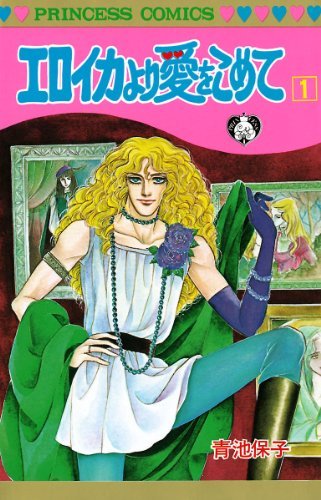
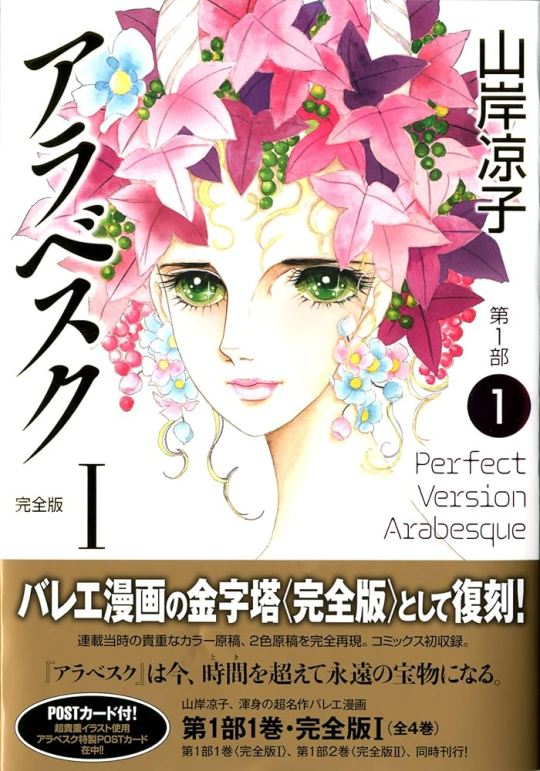
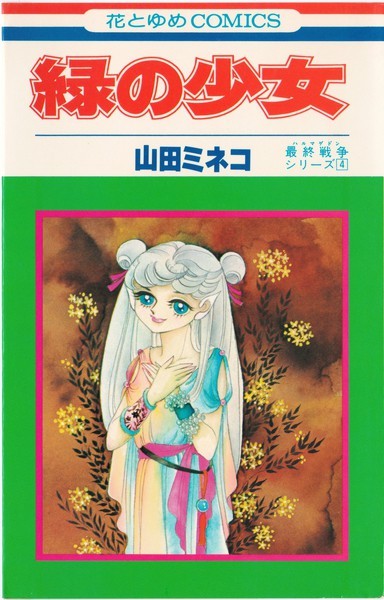

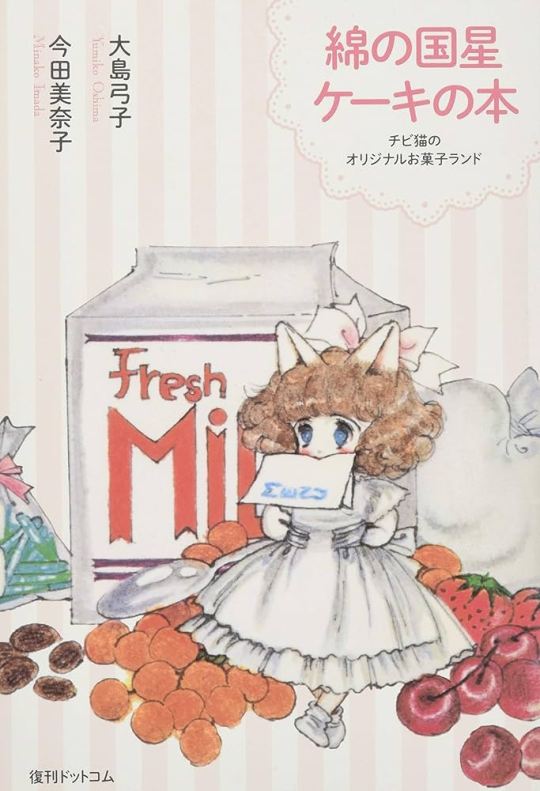

Some of the best-selling work by the Year 24 Artists (l-to-r): Yasuko Aoike's "From Eroica with Love," Ryoko Yamagishi's "Arabesque," Mineko Yamada's "Minori no Shoujo," Toshie Kihara's "Yomie no Ishibume," Yumiko Oshima's "The Star of Cottonland," Yuuko Kishi's "Tamasaburo."
Back in the early '70s, there was the prevailing notion that manga was for young kids. Despite the variety in themes, big magazines like Margaret, Shoujo Club, Nakayoshi, and Ribon were theoretically aimed at elementary school-aged girls.
In practice, the reality was more nuanced. Due to being published in Weekly Margaret, "The Rose of Versailles" was for kids. And it did very well with them. Yet, its revolutionary romance also appealed to broader audiences, exemplifying the crossover potential of shoujo manga. It was the title that opened the door for what is known as "the golden age of shoujo," which was further cemented by several other groundbreaking hits.
These hits widened the shoujo manga field, and soon, other editorial houses also wanted to cash in. Shogakukan, which published the powerful Weekly Shonen Sunday, entered the shoujo market in the late '60s. Shueisha and Shogakukan also partnered to form a keiretsu and open the Hakusensha publisher which deals mostly with shoujo manga.
That is the context in which a batch of artists known as "The Magnificent 24 Group" rose. And they were another key reason as to why '70s shoujo made such a mark. These manga-kas introduced themes such as sci-fi and homosexuality to the segment, revolutionized its art, further explored historical and terror narratives, and generally broke barriers of what was possible in shoujo manga. Their work was intellectually challenging, philosophical, and, above all, fundamental for male manga critics and connoisseurs to finally take shoujo seriously.
The Year 24 Group refers to the fact most artists were born around 1949, which is known as the year 24 of the Showa era in the Japanese calendar. These women came of age during the time artists like Hideko Mizuno were debuting and doing revolutionary work in the shoujo field, and they were eager to follow their lead. The success of unorthodox hits like "The Rose of Versailles" and the emergence of new magazines enabled them to be bold.
The two artists who led the movement are Moto Hagio and Keiko Takemiya. Their shared house in Tokyo, known as the Oizumi Salon, became a gathering place for several young artists keen on breaking new grounds for shoujo manga-kas. These women became the Year 24 group. But there were other two people, besides the artists themselves, who were just as crucial for their collective rise.
Firstly, there was Junya Yamamoto. Yamamoto was a young male editor at Shogakukan who had risen through the ranks of the successful Shonen Sunday weekly manga magazine. Noticing they were lagging behind Shueisha and Kodansha in the manga segment for their lack of a robust shoujo presence, the editorial house appointed Yamamoto to launch Shoujo Comic (known as Sho-Comi) in 1968 and Bessatsu Shoujo Comic (known as Betsucomi) in 1970. However, he quickly ran into an issue: most successful shoujo artists already had exclusive contracts with the competing houses, and aspiring names were vying for positions at the already established titles.
In 1969, the "God of manga," Osamu Tezuka, introduced Yamamoto to Keiko Takemiya, then a university student living in Tokushima City. Takemiya had spent her school years dreaming of becoming a manga-ka and participated extensively in the readers' corner section of COM. COM was an avant-garde manga magazine Tezuka founded to nourish young talents and publish stories without the typical restraints of more commercial shoujo and shonen publications. In her first year of college, Takemiya won a Shueisha's Weekly Margaret newcomer competition and had a work published in the magazine. Still, she was persuaded by her parents to focus on her studies instead and to leave manga as a side hobby.
Yamamoto, in turn, was impressed with her talent and convinced her to chase her dreams. Quickly, she found work in all three publishers and started simultaneously publishing in Kodansha, Shueisha, and Shogakukan's shoujo titles.
Meanwhile, Moto Hagio also grew up enamored with the manga world. During her college years, she had a work selected by Shueisha's Bessatsu Margaret (Betsuma) through a competition, but she could not find a fixed slot in the magazine. Then, she got introduced to Kodansha's Nakayoshi editors, who were impressed by her talent. While she did start publishing short stories there, editors rejected most of her submitted work as they did not fit the magazine's mold. One day, an editor introduced her to Takemiya, who, overworked while working for several magazines, was in dire need of an assistant. The two hit off, and Takemiya, who until then had her permanent residence in far away Tokuma City but was planning a move to Tokyo, proposed they both live together. She also decided to introduce Hagio to risk-taker editor Yamamoto, who, impressed by her talent, encouraged her to pursue her path instead of trying to fit into the expected shoujo template.
Then there was Norie Masuyama, who first became acquainted with Moto Hagio before becoming Takemiya's manager. Hagio was from Fukuoka, while Masuyama was from Tokyo, but due to their similar interests, they became penpals. When Hagio first moved to Tokyo, Masuyama hosted her in her home in Oizumi. Eventually, Hagio introduced Masuyama to Takemiya, and the three of them became close. Because both were artists from outside of Tokyo, Masuyama was the one who first circled the idea they should live together (something Yamamoto presciently warned it could turn into a problem), and she was the one who alerted them of a house in her Oizumi neighborhood being up for rent.
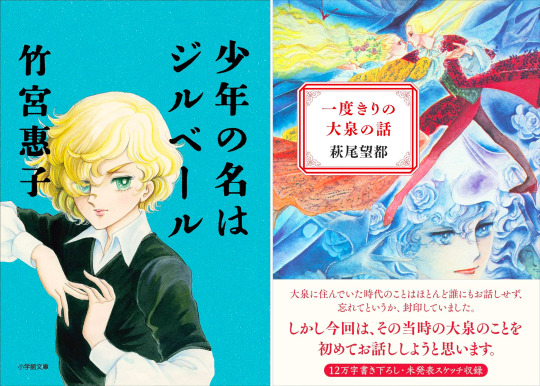
Keiko Takemiya and Moto Hagio, estranged since the late '70s, revealed details of their feud in autobiographic books: Takemiya's "Shonen no na wa Gilbert" (2019) and Hagio's "Ichidou kiri no Oizumi no Hanashi" (2021). The dispute, stemming from Takemiya accusing Hagio of plagiarism, was fueled by Takemiya's jealousy during a challenging creative and personal period. While Takemiya appears self-aware and analytical in her account, Hagio's book indicates she hasn't forgiven Keiko, revealing unresolved feelings. The publications triggered intense online debates.
Masuyama came from a sophisticated family that was very involved in arts and, from a young age, got familiarized with the world of music, literature, and movies. Her refined taste impressed Hagio and Takemiya. At a time when Japanese girls dreamed of Europe, Masuyama actually had friends living there and was up-to-date on the latest European trends. She also had a lot of knowledge of European cinema and literature.
As their rented house was old and rusty, Hagio and Takemiya started spending a lot of time at Masuayama's house across the street. She introduced them to films, songs, books, and paintings. It was Masuyama's taste -- including her interest in movies and books depicting gay romance and her desire for girls' comics to have bolder and riskier themes -- that helped to instill a passion in both artists to go further than the safe cliches usually depicted in shoujo works.
In 1970, editor Yamamoto convinced Takemiya to sign an exclusive contract with Shogakukan. The following year, Hagio also started publishing for Sho-comi and Betsucomi. Their work would attract a loyal fanbase, and aspiring manga-ka would flood their mailboxes. So Takemiya made a decision: to select female artists around her and Hagio's age to mentor and train at their shared home. Thus, the Oizumi Salon was born.
Despite attracting attention, Takemiya and Hagio's works were not always popular. In fact, they'd often rank last in readers' popularity polls, which tend to be all-deciding in manga magazines. But they persevered, and Yamamoto trusted them.

Keiko Takemiya aimed to establish herself with a top-rated series through "Pharaoh no Haka" (left) in order to garner the necessary respect from editors to write the series she wanted, "Kaze to ki no uta" (right). Despite her resolute efforts, "Pharaoh no Haka" never secured the top spot in Sho-comi's readers' poll, peaking at #2. Nevertheless, the series succeeded in elevating her fame and earning her the respect she sought.
In 1972, Hagio had an idea for a serial focused on a male European vampire. However, as she wasn't a famous artist, Yamamoto only allowed her to publish one-shots. So she came up with a plan: to write three interconnected standalone stories. To circumvent another restraint - shoujo editors' avoidance of male leads - she put the first story focus on Marybelle, Edgar's sister. Once Yamamoto realized what Hagio was doing, he was amused and allowed her to continue. And so, "The Poe Clan" series began. In 1974, Shogakukan finally started publishing their shoujo titles in compiled paperback format. In another proof of trust, Yamamoto chose Hagio's "The Poe Clan" as the first title of the Flower Comics imprint.
To everybody's surprise, "The Poe's Clan," in paperback format, was a groundbreaking success, almost instantaneously selling out its initial printing. At the time, Hagio had just started a new serialization, "The Heart of Thomas," a tragic gay love story set in an all-boys German school. As usual for her, the story wasn't all that popular with Sho-Comi's readership, and its lackluster results in the reader's poll almost got the series discontinued. But the notable success of "The Poe's Clan" tankobon assured editors, who allowed Hagio to continue the series. "The Heart of Thomas" went on to become another best-seller and a seminal shoujo title. It also attracted critical acclaim and a loyal fanbase to Moto Hagio, which in turn helped put the Year 24 artists -- who were pretty good at self-promotion -- in the spotlight.
Hagio, Takemiya, and several other "Year 24" authors drifted between being popular and underground. They had a sizable, loyal fanbase that followed them and turned several of their works into best-sellers. On the other hand, by finding a way around the usual shoujo traditions, they weren't particularly popular with the average shoujo reader, ordinary young girls across the country.
Their peculiar position forced them to be clever, so they could fulfill their creative desires as well as their editors' expectations, who were there to make sure the stories published were satisfying to the core readership. Takemiya wrote "Pharaoh no Haka," an Egypt-set romantic adventure, to be well-accepted so that she could then dedicate herself to doing what she truly wanted in "Kaze to Ki no Uta," a gay love story set in a 19th Century French boarding school.
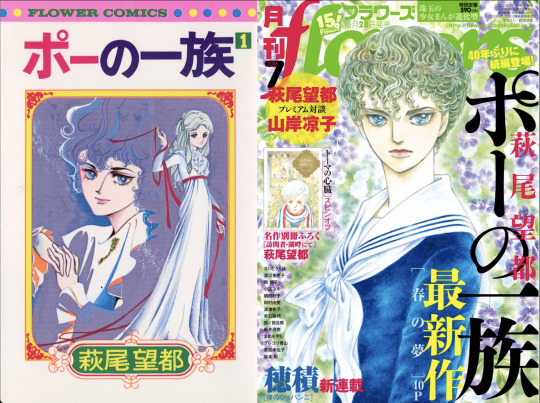
Initially overlooked in popular shoujo magazines, Moto Hagio gained success with "The Poe Clan" in compiled format, launching Shogakukan's Flower Comics imprint. Over time, she became a highly respected manga artist, the only manga-ka alongside legendary filmmaker Hayao Miyazaki to receive a Person of Cultural Merit recognition. In 2016, marking 40 years of the conclusion of her first hit, she released a new "The Poe Clan" chapter in Flower magazine, selling out the increased print run of 50,000 copies in a day. This success marked a significant shift for Hagio, who, despite not being a major magazine seller in earlier years, became a valuable asset to the struggling magazine publishing industry decades later. Following the one-shot, she released three more chapters and, in 2022, began a new sequel series.
Besides Takemiya and Hagio, several other notable shoujo artists who went on to become huge names used to frequent the Oizumi Salon and were part of the "Year 24 group." In the early '70s, most published their work on Shogakukan's titles, which had a "free policy" on storytelling compared to Margaret, Shoujo Friend, Nakayoshi, and Ribon. Then, as Shogakukan started being more strict to properly compete with the market leaders, several moved to newly launched Hakusensha titles Hana to Yume and LaLa. Influential names that were part of the movement included Yumiko Oshima, Yasuko Aoike, and Ryoko Yamagashi, among several others.
Despite their unorthodox preferences, they weren't necessarily trying to rebel against the system, they simply wanted to put out good quality work they believed in. Like other Japanese girls from that era, they were fascinated by Europe, and plenty of their stories took place on the continent. In 1972, Hagio, Takemiya, Yamagishi, and Masuyama made a 45-day trip to Europe, visiting the Soviet Republic, France, and several other countries, which had a profound impact on them. Still, their narratives were widely innovative. They often had male leads, introduced sci-fi, "boys' love," and other bolder genres to shoujo manga, and contributed to the evolution of shoujo illustration. Above all, this group of artists was the one who made clear to naysayers, once and for all, that shoujo manga is indeed an art form.
But while their influence in manga history is undisputed, other significant -- and much more commercial -- manga movements also shook the shoujo manga world during that decade.
A Need for Drama
When talking about '70s shoujo manga, it's common for minds to drift directly to iconic series from that time, like "Candy Candy" and "Rose of Versailles." But, unlike in present times, in that decade, the manga industry's focus wasn't on successful, long-running series but on the artists themselves.
As opposed to the struggling publishing marketing of today, major shoujo manga magazines all sold over 1 million copies during that decade. Manga in tankobon (standalone paperback) format was turning into a money-maker field, but being able to sell paperback was very much secondary compared to being a name capable of selling magazines. Keiko Takemiya and Moto Hagio, from the Amazing Year 24 Group, would go on to become household names and had best-selling series, but, at the time, they couldn't compete with the actual shoujo manga superstars who were the signboard artists of the Kodansha and Shueisha's shoujo titles, the ones who actually moved publications. These artists' work was the most significant indicator of what the mainstream readers wanted and aspired to back then.
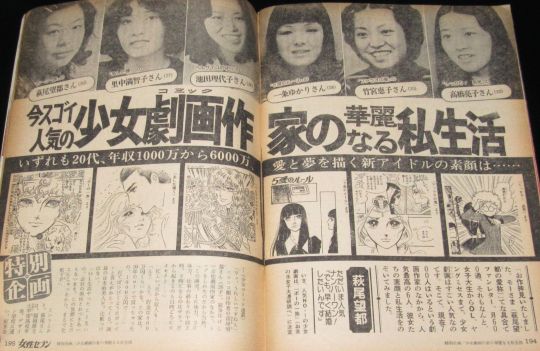
In a December/1975 issue, weekly Josei Seven spotlights the new generation of superstar shoujo manga artists: (l-to-r) Moto Hagio, Machiko Satonaka, Ryoko Ikeda, Yukari Ichijo, Keiko Takemiya, and Ryoko Takahashi. While contemporary manga-kas are highly discreet about their lives and do not even tend to show their faces, in the '70s, they were treated like superstars, and, in the article, the manga-kas openly discuss their love life and details of their high incomes, including how much they had in the bank and how much they spent on rent and daily utilities.
For Kodansha, the top shoujo artist was definitely Machiko Satonaka, who won the Best New Artist competition in 1964, when she was still a freshman in high school. There have been several high-schoolers making their debut in the industry throughout the decades, but, as the first, Satonaka caused a media frenzy. Her ascent gave confidence to countless other young women -- from "Glass Mask"'s Suzue Michi to Keiko Takemiya (who also won a smaller prize in the same competition) -- to pursue their manga careers.
The attention surrounding Satonaka, who went on to become a public personality with TV hosting gigs and other appearances, is another interesting, nostalgic phenomenon. In the past, it was common for manga superstars to have a strong media presence. Nowadays, the norm is the complete opposite: for manga-kas to be highly private, no matter how famous their work is.
In any case, Satonaka quickly proved herself to be more than a sensational news story as she created extremely popular mangas for Kodansha shoujo titles like Shoujo Friend and Nakayoshi. Her style, widely accepted by readers, became symbolical of the story-telling the '70s girls craved: extremely dramatic with emotionally driven plots and lots of bombastic twists and developments.
In his book on subcultures and otaku culture, sociologist Shinji Miyadai notes that '70s shoujo manga can be divided into very few categories. There is the category the Year 24 artists dominated -- which he defines as the "Moto Hagio domain" -- of works with a lot of artistic value, up-to-par with literature. And then there's the far more commercially viable "Satonaka domain," which represented the mainstream taste.
In the "Satonaka category," the artist depicts a stormy life story as a proxy experience for the readers. Of course, there are universal elements of love, friendship, and insecurity that girls can directly relate to. Still, these stories provide adventures that readers could never experience in the real world.
These facets of the "Satonaka domain" are present in almost all the best-selling, mainstream shoujo series of the '70s, like the revolutionary historical romance of "The Rose of Versailles," the dramatic rags-to-riches story of the beautiful orphan in "Candy Candy," and the rise of an ordinary girl to the top of the sports elite in "Ace wo Nerae." In all of these titles, you'll also spot other defining characteristics of '70s shoujo: the death of beloved characters and well-liked female characters with voluminous blonde hairs and huge, sparkling eyes (a legacy of Macoto Takahashi, the illustrator who, throughout the '50s, created the art that directly influenced subsequent shoujo history).
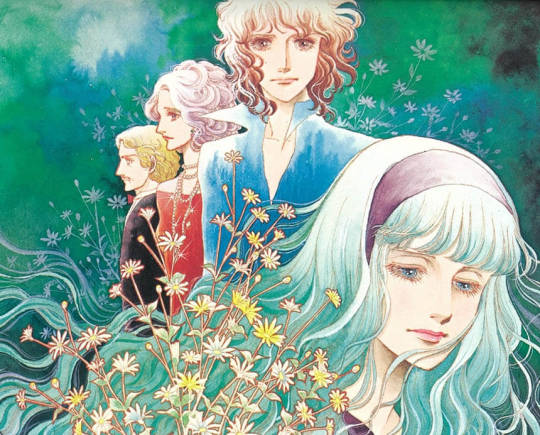
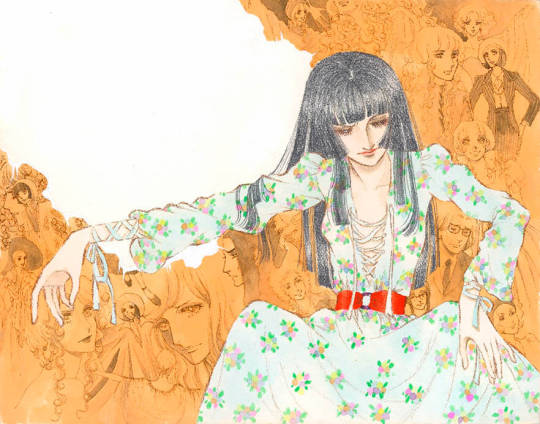
Yukari Ichijo was the most prominent Ribon signboard artist throughout the '70s, creating popular mangas like "Suna no Shiro" (left) and "Designer (right). Young girls across the country adored her work despite the adult drama in it.
Since these stories are extraordinary and dream-like, many of them use Europe or the US as their setting, another reflection of a time when Japanese youth dreamed with the West.
While Satonaka was Kodansha's star, Shueisha also had its top shoujo artists. For Margaret, it was Ryoko Ikeda who kept creating memorable dramatic manga after the conclusion of "The Rose of Versailles." Other classic '70s dramatic works published in the weekly included Kyoko Ariyoshi's ballet drama "Swan." Meanwhile, over at Ribon, no one shone brighter than Yukari Ichijo. Ichijo's works, which young girls across Japan devoured, contained a lot of adult drama with adult characters. Her 1974 manga, "Love Game," had a bed scene. One of her most celebrated works of the decade, "Suna no Shiro" (Sand Castle), dealt with incest. While Ichijo is the one who stood the test of time, another artist who also enjoyed great popularity in Ribon following this formula was Kei Nogami.
These mangas served as an escape for girls, who left their ordinary school life behind for a few hours to embark on extraordinary adventures. In contrast, one of the main genres in contemporary shoujo is unassuming, everyday high school romance. How could the shoujo segment go through such a drastic transformation? The reasons for that also dates back to the 1970s.
Part 3
#shoujo manga#vintage shoujo#otometique#yumiko oshima#keiko takemiya#yumiko tabuchi#hideko tachikake#machiko satonaka#yukari ichijo#ribon#1970s japan#1970s#year 24 group#moto hagio#vintage manga
79 notes
·
View notes
Text
Yumi Tamura's Tribute to Moto Hagio, Yūko Kishi, Michi Tarasawa, and Kimiko Uehara in Celebration of Flower Comics' 40th Anniversary (2014)
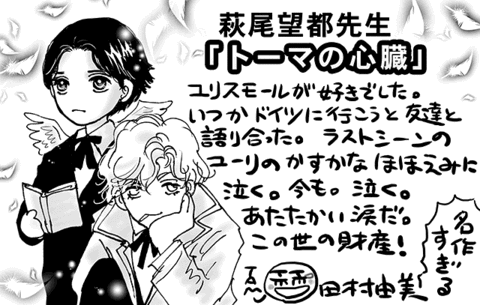
Tamura on Tōma no Shinzō (The Heart of Thomas) by Moto Hagio:
"I loved Julusmole. My friends and I talked about going to Germany someday [because of this manga]. Juli's faint smile in the last scene always makes me cry. Even now. I cry. Warm tears. This manga is a world treasure! (It's too much of a masterpiece)"
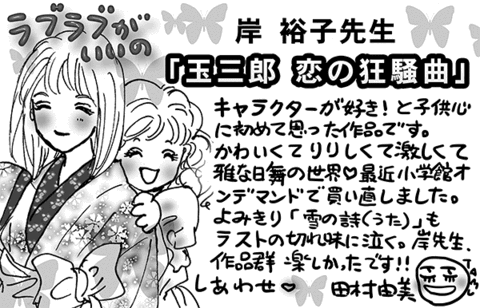
Tamura on Tamasaburō: Koi no Kyōsōkyoku by Yūko Kishi:
"This is the manga in which my young and innocent mind first thought, 'I love the characters!' It shows the cute, dignified, fierce, and elegant world of traditional Japanese dance. I recently bought it again via Shogakukan On-Demand. I cried at the sharp ending in the one-shot, Yuki no Uta. I really enjoyed your works, Kishi-sensei! So happy ♡"
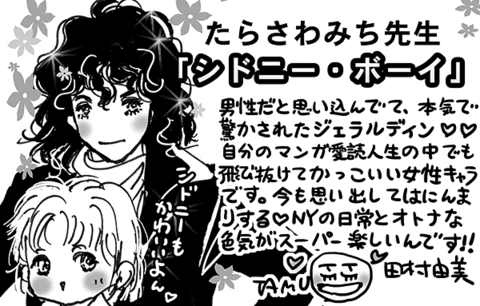
Tamura on Shidonī Bōi (Sydney Boy) by Michi Tarasawa:
"Geraldine seriously surprised me and I was so convinced that she was a man. She's by far one of the coolest female characters I've ever seen in my life as an avid manga reader. Even now, I grin with satisfaction just thinking of her. The everyday life in New York and mature, sexy vibes portrayed in the manga are super thrilling!! (Sydney is so cute too)"
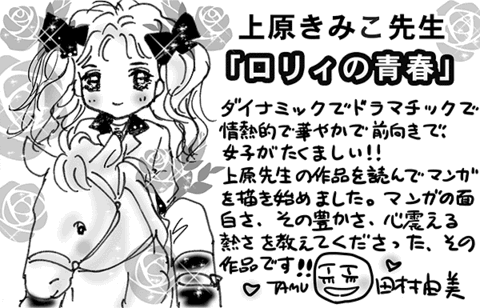
Tamura on Lolly no Seishun by Kimiko Uehara:
"It's dynamic, dramatic, passionate, gorgeous, positive, and is filled with strong, spirited girls!! I started drawing manga after reading Uehara's work. It showed me the fun of manga, its richness and heart-quivering intensity!!"
Disclaimer: These are amateur translations (obviously) and provided for the enjoyment of fans alike (and for personal practice). I do not claim accuracy nor copyright on the translations or content. Feel free to alert me of any corrections.
#tamura yumi#yumi tamura#moto hagio#the heart of thomas#yuuko kishi#tamasaburou#michi tarasawa#sydney boy#kimiko uehara#lolly no seishun#flower comics#tamura tears
32 notes
·
View notes
Text
youtube
So, uh... This is a video I've made literally a decade ago for a quizz on Sporcle. With all these copyright problems I never for once thought this video would resist and win(?) the battle, so I'm posting it here now lol. I would love to make more of this, but because of the after mentioned reasons, this is the only one. Everybody is always recalling about opening songs, so of course I felt the need to make something big about ending songs. The songs I chose are VERY random because I tried to make the game enjoyable by not making something so easy that you can answer it just by reading the name of the songs alone. Also, the mixing is a mess but I assure you it still worth listening lol. If you don't want to play the game and just listen to a megamix, here's the tracklist: 01. Nana Kitade - Kesenai Tsumi (Hagane no Renkinjutsushi/FullMetal Alchemist) 02. Berryz Koubou - Nanchuu Koi wo Yatteruu YOU KNOW? (Patalliro! Saiyuki) 03. KOTOKO - →unfinished→ (Accel World) 04. Youko Takahashi - Yoake Umare Kuru Shoujo (Shakugan no Shana) 05. team-F - Hohoemi wo Agetai (Princess Princess) 06. Kinya Kotani - Glaring Dream (Gravitation) 07. Maki Kimura - Ano Hi ni... (Den'ei Shoujo/Video Girl Ai) 08. Kana Nishino - Style. (Soul Eater) 09. Yui Sakakibara - Beautiful Day (Boku wa Otome ni Koishiteru) 10. AiM - Keep On (Digimon Adventure) 11. Hiroki Wada - Mystic Eyes (Tenkuu no Escaflowne/The Vision of Escaflowne) 12. AYANA - Kaze no Tadoritsuku Basho (Kanon) 13. Mai Nakahara & Ai Shimizu - Himitsu Dolls (Strawberry Panic) 14. Franz Ferdinand - Do You Want To (Paradise Kiss) 15. the indigo - Namo Shirenu Hana (Ai Yori Aoshi) 16. Younha - Houkiboshi (Bleach) 17. Kohmi Hirose - Groovy! (Cardcaptor Sakura) 18. Keiko Yoshinari - Asu e no Yuuki (Mahou Kishi Rayearth/Magic Knight Rayearth) 19. Shouko Nakagawa - Happily ever after (Tengen Toppa Gurren Lagann) 20. Mai Yamane - The Real Folk Blues (Cowboy Bebop) 21. Claire - Fly Me to the Moon (Shin Seiki Evangelion/Neon Genesis Evangelion) 22. Akemi Kanda, Ai Nonaka, Mamiko Noto & Yuu Kobayashi - Kagayaku Kimi e (Mahou Sensei Negima!) 23. Ritsuko Okazaki - Chiisana Inori (Fruits Basket) 24. Atsuko Enomoto & Chihiro Suzuki - Yume no Naka e (Kareshi to Kanojo no Jijou) 25. T.M.Revolution - HEART OF SWORD ~Yoake Mae~ (Rurouni Kenshin ~Meiji Kenkaku Romantan~) 26. TM NETWORK - Get Wild (City Hunter) 27. Mitsunori Ikeda ft. Aimee B - Fallen Angel (Panty & Stocking with Garterbelt) 28. Yifei - Mayonaka no Door (Demaashita! Powerpuff Girls Z) 29. Buono! - Kiss! Kiss! Kiss! (Shugo Chara!) 30. Yukari Konno - Tokimeki no Doukasen (Fushigi Yuugi) 31. Naoko Hamasaki - Tensai wa Saigo ni Yatte Kuru (Elf wo Karu Monotachi/Those Who Hunt Elves) 32. AKIMA & NEOS - Kaze wa Mirai ni Fuku (Trigun) 33. r.o.r/s - escape (Kaleido Star) 34. Koh Ikeda - Eien ni Amuro (Kidou Senshi Gundam/Mobile Suit Gundam) 35. Ichirou Mizuki - Bokura no Mazinger Z (Mazinger Z) 36. Aya Hirano, Minori Chihara & Yuuko Gotou - Hare Hare Yukai (Suzumiya Haruhi no Yuuutsu) 37. Youko Ishida - Otome no Policy (Bishoujo Senshi Sailor Moon R) 38. LEGOLGEL - Mirai (Corrector Yui) 39. LAST ALLIANCE - Shissou (Ouran Koukou Hostbu/Ouran Highschool Host Club) 40. Sheryl Nome starring May'n - Northern Cross (Macross F) 41. Sakurakou Keionbu - Don't say "lazy" (K-on!) 42. Luca Yumi - Truth (Shoujo Kakumei Utena/Revolutionary Girl Utena) 43. Satoko Shimizu - Sajin no Meizu (Tenkuu Senki Shurato)
4 notes
·
View notes
Text
Valkyrie Connect voice actors
I’ve been looking all over the Internet for a cast list of this game, but came up with nothing (really, people?). So I figured I’d make one myself! Mind you, I don’t have all characters so feel free to let me know anything I missed. MALE CHARACTERS Akira Ishida: Kaworu Nagisa Aoi Yuuki: Utgardar Asami Shimoda: Kagamine Len Daisuke Ono: Odin Hiro Shimono: Loki Hiroki Takahashi: Ryu Hironori Kondo: Krozak, Vidofnir Hiroshi Kamiya: Levi Hiroshi Okamoto: Fafnir, Lucio, Ymir (Armored) Jouji Nakata: Morphia Jun Fukuyama: King Junichi Suwabe: Archer Kappei Yamaguchi: Sigurd Kenjiro Tsuda: Skirnir Kouji Haramaki: Prastos Makoto Naruse: Alviss, Hrungnir, Nagato Mamoru Miyano: Gilthunder Marina Inoue: Baldr Megumi Han: Arnaud, Ymir (Boy) Megumi Ogata: Shinji Ikari Motomu Kiyokawa: Filsius Nobutoshi Canna: Lancer Noriaki Sugiyama: Shirou Emiya Shoutaro Morikubo: Bergelmir Shunsuke Kanie: Heidrun Taishi Murata: Hodr, Wolfgang Takanori Hoshino: Iori Yagami, Loewe Taketora: Akuma Tatsuhisa Suzuki: Ban Tomoaki Maeno: Kyo Kusanagi Tomokazu Seki: Gilgamesh, Thor Tomokazu Sugita: Gylfi, Tyr, Vidar Toshiya Chiba: Sleipnir Tsuguo Mogami: Omega Rugal, Volundr Volcano Ohta: Froggy, Geyser Yasunao Sakai: Ofnir Yasunori Masutani: Fenrir, Heimdall, Jormungand, Surtr Yohei Azakami: Ragnarok, Zato Yuei Takagi: Gowther Yukari Tamura: Magni Yusei Oda: Boelthor, Nidhogg, Thiazi, Welver / previously known as Katsuaki Arima Yuuji Kishi: Ken Yuuki Kaji: Eren, Meliodas Yuuki Ono: Helblindi, Huginn, Susano-o Yuuma Uchida: Hraesvelgr, Reginleif Yuuta Kasuya: Xiang Tong Yuuya Uchida: Hendrickson FEMALE CHARACTERS Ai Nonaka: Kyoko Sakura, Mani, Nautica, Ranco, Verdandi Ai Sasaki: Luflit, Momiji, Nadia Akane Fujita: Jord, Nerthus Akira Sekine: Cenia, Ines Ami Koshimizu: Alice, Mai Shiranui Aoi Koga: Clarisse Aoi Yuuki: Diane, Eihwaz, Hyuga, Madoka Kaname, Randgrid Asami Shimoda: Etricia, Granfelt, Kagamine Rin Aya Endo: Karin Aya Suzaki: Raspi, Rota, Verossa Aya Uchida: Dielle, Nyatasha, Saskia, Tamamo Ayaka Fujimoto: Kushinada, Soable Ayaka Fukuhara: Clarice, Hrist Ayaka Maeda: Stella, Sylva Ayaka Ohashi: Elena, Elsa, Sortishia Ayako Kawasumi: Saber Azumi Asakura: Authumla, Osiris Chika Anzai: Fubuki, Nori Chiwa Saito: Akemi Homura, Skuld Eri Kitamura: Sayaka Miki Eri Sendai: Izuna, Rapunzel, Ultima Fumiko Orikasa: Chun-Li Haruka Terui: Liciela, Liesa, Matisse, Maully Haruna Ikezawa: Athena Asamiya, Lamina Hiromi Igarashi: Blodu, Chihaya, Forte, Livy & Lo, Tesla, Velfell Hisako Kanemoto: Tholin, Tinker Kaede Hondo: Porte, Viola Kana Ueda: Aquaria, Carliss, Estella, Rin Tohsaka, Risa, Sif, Urd Kanae Itou: Herja, Lorelei Kanako Nomura: Bylgja, Gaia, Oboro Kaori Mizuhashi: Arte, Mami Tomoe, Mimir Kaori Nazuka: Hervor, Roveria Konomi Kohara: Mervelin Kotono Mitsuishi: Misato Katsuragi Maaya Sakamoto: Hel, Mari Makinami Maaya Uchida: Esquire, Quarys Madoka Yonezawa: Forseti, Vili Mai Aizawa: Anubis, Idun, Luca, Mele Mai Kadowaki: Amaterasu, Illyasviel, Mia, Zodie Mamiko Noto: Frey, Lolo & Nana, Neviria Maria Naganawa: Camilly, Mogthrasir Maria Uno: Solstis Marina Inoue: Bertha, Dora, Ipsum Masumi Asano: Avencia (?), Brunhild, Litany, Muninn, Sakeko Megumi Han: Kubira, Michelle Megumi Hayashibara: Rei Ayanami Minami Takahashi: Hanna, Kaguya, Lorone Minami Tsuda: Materia, Sandra Miyu Tomita: Aurora, Frigg Miyuki Sawashiro: Cammy, Freya, Gullveig Nanaka Suwa: Beatrix, Eysith, Walpurgis Naomi Oozora: Angrboda, Marmalade, Niji, Noa, Passo, Zweilie Nozomi Sasaki: Grace, Yatsude Nozomi Yamamoto: Terra, Vesmeral Rie Kugimiya: Demolisha, Hymir, Norn, Nott Rie Murakawa: Rita, Ulin Rina Satou: Sara, Yvette Romi Paku: Hange Rumi Ookubo: Igna, Mei Hou, Radgrid Ryoko Shiraishi: Lu Ling, Siluria Saki Fujita: Hatsune Miku, Senna Saori Hayami: Bestla, Cherie, Mikagura, Nabby, Sanngrid Satomi Satou: Gardina, Medjed, Petra, Sol Sayaka Senbongi: Bear, Kagutsuchi, Lipka, Svipul Shiori Mikami: Flora, Mirka, Krista, Sinmara Shizuka Itou: Cleo, Fenia Sora Amamiya: Elizabeth Sumire Morohoshi: Nocturna, Tomoe Umeka Shouji: Corona, Skadi, Sonia Yoko Hikasa: Ayame, Bara, Dinna, Ran, Sentia Yui Ishikawa: Mikasa Yui Kano: Jest, Sasha, Shiena, Thrud, Vali Yukari Tamura: Pallone, Poelle Yuki Nagaku: Fei Lang, Sakura, Soara Yukiyo Fujii: Lyrist, Tsukuyomi Yumi Hara: Eleneige, Shuirin Yumi Kakazu: Kula Diamond, Mizuki Yumi Sudou: Aegir, Canon, Kili Yuu Asakawa: Megurine Luka Yuuki Kuwahara: Mona, Souffle, Vendetta Yuuko Miyamura: Asuka Langley Sohryu Yuuko Sumitomo: Curtana, Lumiere UNKNOWN OR UNVOICED 6th Angel Armored Titan Garm niconico televi-chan Pseudo DMS Unit-13 COMMENTS 1. Aoi Yuuki, Asami Shimoda, Marina Inoue, Megumi Han and Yukari Tamura are the only women I’ve found so far that play both male and female characters. 2. Listen to the differences between Taishi Murata’s characters. His range never ceases to amaze... the only English voice actors with similar ranges (that I know of) are Ben Diskin and Sean Chiplock. 3. On the female side, Umeka Shouji has a surprisingly large range. I’ve mostly heard her play deeper-voiced roles, and then Corona shows up... 4. I love Hiro Shimono’s evil laugh. He doesn’t go all out with Loki, but he sounds like an insane seagull when he does. 5. As a mythology fangirl, I’m a little annoyed by all the changes. Frey, Mani and Vali are supposed to be male; Skuld is supposed to be a Norn (with Verdandi and Urd); Hel, Fenrir and Jormungand are supposed to be Loki and Angrboda’s kids; Idun is supposed to be Bragi’s wife; Thrud is supposed to be Thor’s daughter and Magni and Modi his sons. I’ll update this “lore correction” once I find more characters.
18 notes
·
View notes
Video
youtube
“Ulysses: Jeanne d'Arc to Renkin no Kishi” anime PV3. Series begins October 7th (AXsiZ)
-Synopsis-
“The story is set in the 15th century, during the Hundred Years’ War between France and England over the succession to the French throne. Montmorency, the son of a noble, immerses himself in the studies of magic and alchemy at a royal knight training school. However, following France’s crushing defeat at Agincourt, the school is dissolved. Having lost everything and now a wanted man, Montmorency, who had just become an alchemist, encounters a mysterious village girl named Jehanne.”
-Staff-
Director: Shin Itagaki
Series Composition: Ryunosuke Kingetsu
Character Design: Jouji Sawada
Music: Taku Iwasaki
OP: Mai Fuchigami
ED: rionos
Studio: AXsiZ
-Cast-
Ryouta Osaka
Yuuko Ono
Hisako Tojo
Manami Numakura
Saori Onishi
Yuuki Takada
Shizuka Ishigami
via: http://ulysses-anime.jp/
7 notes
·
View notes
Text
Top 30 Greatest Anime Quotes of All Time
Are you an anime fan? Who among your many favorite anime characters said the most inspiring and meaningful quote? Here are my Top 30 Best Anime Quotes to encourage you in finding out which one is the best. I know there are hundreds of other anime quotes out there that I’ve forgotten so please don’t hesitate to leave a comment if you know any that is far better than the ones on my list. Have a good read and I hope these best anime quotes will inspire you to do your best and stay hopeful in achieving your goals in life!
Archer Quotes (Fate/stay night: Unlimited Blade Works)
"I am the bone of my sword Steel is my body and fire is my blood I have created over a thousand blades Unknown to Death, Nor known to Life Have withstood pain to create many weapons Yet, those hands will never hold anything So as I pray, Unlimited Blade Works."
Jiraiya Quotes (Naruto)
“The true measure of a shinobi is not how he lives but how he dies. It’s not what they do in life but what they did before dying that proves their worth."
Monkey D. Luffy Quotes (One Piece)
“I don’t want to conquer anything. I just think that the guy with the most freedom in this ocean is the Pirate King!”
Vash the Stampede (Trigun)
“If you only face forward, there is something you will miss seeing.”
Hitsugaya Toushiro (Bleach)
“We are all like fireworks. We climb, shine, and always go our separate ways and become further apart. But even if that time comes, let’s not disappear like a firework, and continue to shine forever.”
Clare (Claymore)
“Don’t be so quick to throw away your life. No matter how disgraceful or embarrassing it may be, you need to keep struggling to find your way out until the very end.”
Roy Mustang (Fullmetal Alchemist)
“The world’s not perfect, but it’s there for us trying the best it can. That’s what makes it so damn beautiful.”
Charles Beams Quotes (Eureka Seven)
"Freedom is something that you need to actively acquire. It's not something that's given with no strings attached. To be free means to take responsibility, and to prepare yourself for what's to come."
Deneil Young Quotes Uchuu Kyoudai (Space Brothers)
"All we can do is live until the day we die. Control what we can...and fly free!"
Edward Elric Quotes (Fullmetal Alchemist)
"A lesson without pain is meaningless. For you cannot gain something without sacrificing something else in return. But once you have recovered it and made it your own... You will gain an irreplaceable Fullmetal heart."
Gildarts Clive Quotes (Fairy Tail)
"Fear is not evil. It tells you what weakness is. And once you know your weakness, you can become stronger as well as kinder."
Gintoki Sakata Quotes (Gintama)
"The country? The skies? You can have them. I’m busy just protecting what’s right in front of me. I don’t know what’ll happen to me in the future, but if something has fallen at my feet, then the least I can do is pick it up."
Hiluluk (One Piece)
"When do you think people die? When they are shot through the heart by the bullet of a pistol? No. When they are ravaged by an incurable disease? No. When they drink a soup made from a poisonous mushroom!? No! It’s when they are forgotten."
Ikki Kurogane Quotes (Rakudai Kishi no Cavalry) (Chivalry of a Failed Knight)
"In order for a mediocre man to defeat a genius, he has to become a monster."
Jae-ha (Akatsuki no Yona) (Yona of the Dawn)
"If you simply obey orders without question to protect your master, that isn't your greatest wish, but your greatest tragedy."
Kaitou Kuroba (Magic Kaitou 1412)
"I'm not here tonight as the son of Touichi Kuroba, your mentor in magic, nor as the second-year high school student you call 'Young Master'. Tonight I'm the one they're all talking about. I'm the villain putting on a show."
Kenshin Himura Quotes (Rurouni Kenshin: Meiji Kenkaku Romantan)
"Whatever you lose, you'll find it again. But what you throw away you'll never get back."
Kenshirou (Hokuto no Ken) (Fist of the North Star)
"You are already dead."
Kino (Kino no Tabi: The Beautiful World) (Kino's Journey)
"The world is not beautiful, and that is why it is beautiful."
Kuu Quotes (Haibane Renmei)
"Inside my mind, there's a beautiful cup. A very beautiful, clear cup. And tiny drops kept falling into it, 'drip, drip, drip', slowly but steadily, everyday. And today, I felt the cup had finally become completely full."
Mikasa Ackerman Quotes (Shingeki no Kyojin) (Attack on Titan)
"The world is cruel, but also very beautiful."
Mitsuyoshi Anzai (Slam Dunk)
"When you give up, that's when the game ends."
Motoko Kusanagi (Ghost in the Shell 2: Innocence)
"We weep for the blood of a bird, but not for the blood of a fish. Blessed are those with a voice. If the dolls could speak, no doubt they'd scream, "I didn't want to become human."
Satsuki Kiryuuin Quotes (Kill la Kill)
"Fear is freedom! Subjugation is liberation! Contradiction is truth! Those are the facts of this world! And you will all surrender to them, you pigs in human clothing!"
Son Goku Quotes (Dragon Ball Z)
"I am the hope of the universe. I am the answer to all living things that cry out for peace. I am protector of the innocent. I am the light in the darkness. I am truth. Ally to good! Nightmare to you!"
Usagi Tsukino Quotes (Bishoujo Senshi Sailor Moon)
"You can't judge how beautiful a girl really is by the way she looks."
Yuu Himura (ef: A Tale of Memories)
"There are no miracles in this world. There is only coincidence and necessity, and what people make of it."
Yuuko Ichihara (xxxHOLiC)
"There is no such thing as a coincidence in this world. There is only the inevitable."
Yuuta Takemoto (Hachimitsu to Clover) (Honey and Clover)
"As time passes, the day will come when everything will fade to memories. But those miraculous days, when you and I, along with everyone else, searched together for just that one thing, will continue revolving forever somewhere deep in my heart, as my bittersweet memory."
Ending Title Card (Cowboy Bebop)
"You're gonna carry that weight."
Sachi (Sword Art Online)
"Even if I die, you keep living okay? Live to see the end of this world, and to see why it was born. Live to see why a weak girl like me ended up here… And the reason you and I met."
1 note
·
View note
Photo


I’m not crying. You are.
Studio feel., despite all the issues with production and delays, you still ended up on top. The story was so sweet and awkward at times that I found it extremely refreshing and heartwarming. The characters were relatable and really down to earth. Seiji Kishi and Yuuko Kakihara, the director and writer, truly created something amazing alongside all the staff that worked on this piece of art.
4 notes
·
View notes
Photo


Tsuki ga Kirei , Promotional Art
Staff:
Director : Seiji Kishi (Angel Beats ! , Assassination Classroom)
Series Composition: Yuuko Kakihara ( Orange, Digimon Adventure tri. )
Original Character Design: loundraw ( Pixiv, Tumblr)
24 notes
·
View notes
Text
Staff and Cast Announcement Made for the Asobi Asobase Anime
Staff and Cast Announcement Made for the Asobi Asobase Anime
A staff and cast announcement has been made for the forthcoming anime adaptation of the Asobi Asobase manga. Seiji Kishi is directing the anime at Lerche, with Yū Kinome as assistant director. Yuuko Kakihara is in charge of series scripts, and Keiko Kurosawa is designing the characters. Masato Kōda is composing the music. The cast includes: Hina Kino is Hanako Honda Rika Nagae is Olivia Konomi…
View On WordPress
0 notes
Photo

Tsuki ga Kirei original TV anime slated for April. Staff:
Original character design: loundraw
Director: Seiji Kishi
Series composition · Script: Yuuko Kakihara
Animation production: feel.
Should’ve reported the leak almost two weeks ago but been putting it off. Oops.
10 notes
·
View notes
Text
Studio feel. Reveals Tsuki ga Kirei Original TV Anime Project for April
Studio feel. Reveals Tsuki ga Kirei Original TV Anime Project for April
Persona 4: The Animation’s Seiji Kishi directs, Yuuko Kakihara pens scripts …read more
Source:: AnimeNewsNetwork
View On WordPress
1 note
·
View note
Photo

Third ‘Asobi Asobase’ Anime DVD/BD Release Packaging Showcased Home » All News » Third ‘Asobi Asobase’ Anime DVD/BD Release Packaging Showcased Third ‘Asobi Asobase’ Anime DVD/BD Release Packaging Showcased 04:00 PM © Rin Suzukawa’ / Hakusensha The summer 2018 anime series Asobi Asobase is getting its home video releases handled by Kadokawa and they’ve set a shortened schedule for it. With the third volume coming up in a couple of weeks we now have a look at the packaging for it ahead of its November 21st, 2018 debut. The twelve episode series is slotted for a four-volume release that began on September 26th, 2018. The DVDs are priced at 8,000 yen each while the Blu-ray’s are priced at 9,000 yen each. Check the full schedule below. Note that the last two discs are getting new mini bonus animation works. Seiji Kishi is directing it based on the series composition by Yuuko Kakihara. Keiko Kurosawa is handling the character designs and studio Lerche is handling the animation production for it. https://www.fandompost.com/2018/11/11/third-asobi-asobase-anime-dvd-bd-release-packaging-showcased/ https://www.instagram.com/p/BqMvHHZlNG-/?utm_source=ig_tumblr_share&igshid=1in38656803eb
0 notes
Text
BLUE ORCHESTRA: l’anime arriverà in primavera, ecco il primo teaser trailer
II manga di Makoto Akui sta venendo adattato da Seiji Kishi, regista di Tsuki ga Kirei e Assassination Classroom.

Oggi NHK ha pubblicato un primo breve teaser per “BLUE ORCHESTRA” (Ao no Orchestra), il quale mostra un paio di innocenti scambi fra i due giovani protagonisti della serie animata, mettendoci subito a nostro agio con una deliziosa sezione di violino, che assieme ai disegni, me la fa già segnare sul calendario.
E a proposito di calendario, l’adattamento del manga firmato Makoto Akui, che mescola scuola, musica e sentimenti, andrà in onda da aprile 2023.
youtube
Prodotta presso lo studio NIPPON AIMATION (Let's Make a Mug Too, Love All Play), la serie sta venendo diretta da Seiji Kishi (Tsuki ga Kirei, Assassination Classroom)

Ad occuparsi della sceneggiatura troviamo Yuuko Kakihara (Chihayafuru, Cells at Work! Lavori in corpo), mentre il design dei personaggi è ad opera di Kazuaki Morita (Assassination Classroom, Classroom of the Elite).
Hajime Aono è un giovane prodigio del violino, che ad un certo momento della sua vita, per motivi personali, finisce per abbandonare il suo strumento. Al suo terzo anno di scuola media, ora fatica a decidere quale percorso accademico intraprendere. Un giorno, a scuola, incontra Ritsuko Akine, un’appassionata violinista alle prime armi che ha intenzione di iscriversi a una scuola superiore che vanta una prestigiosa orchestra scolastica. Man mano che Hajime si avvicina a Ritsuko, finisce per essere riportato nel mondo dei violinisti.
La sua vita riprende il via, quando suoni e cuori cominciano a risuonare in armonia.
Il violino che si sente nel video, è quello del violinista Ryota Higashi, che eseguirà tutte le parti suonate dal protagonista, Hajime Aono.

Il manga è stato lanciato nel 2017 e viene tuttora pubblicato sulla rivista Ura Sunday. Ad oggi, i vari capitoli usciti in Giappone sono stati raccolti in 10 volumetti.
* NON VUOI PERDERTI NEANCHE UN POST? ENTRA NEL CANALE TELEGRAM! *

Autore: SilenziO)))
blogger // anime enthusiast // twitch addict // unorthodox blackster - synthwave lover // penniless gamer
[FONTE]
#blue orchestra#ao no orchestra#anime#serie tv#manga#violino#ryota higashi#makoto akui#seiji kishi#giappone#animazione#cartoni animati#news in the shell
0 notes
Text
TIME of the SEASON Summer 2018 Edition: ASOBI Asobase - workshop of FUN -
Not your average school girl show.
What happens when you think a cute school girl show and mixed it in with the expression of an ugly face you get whether you listen to a fire album or mixtape?
Well, you get this show.
This is Asobi Asobase – workshop of fun -.

Director: Seiji Kishi
Series Composition: Yuuko Kakihara
Music: Masato Kōda
Original creator: Rin Suzukawa
Character Design: Keiko Kurosawa
Sound Director: Satok…
View On WordPress
#Anime#Asobi Asobase#comedy#Crunchyroll#first impression#Lerche#school life#Summer 2018#Time of the Season
0 notes
Photo

youtube
The staff, cast and teaser PV for the “Ulysses: Jeanne d'Arc to Renkin no Kishi” anime is now available. Series premiere October.
-Staff-
Director: Shin Itagaki
Series Composition: Ryunosuke Kingetsu
Character Design: Jouji Sawada
Music: Taku Iwasaki
Studio: AXsiZ
-Cast-
Ryouta Osaka
Yuuko Ono
Hisako Tojo
Manami Numakura
Saori Onishi
Yuuki Takada
Shizuka Ishigami
via: http://ulysses-anime.jp/
15 notes
·
View notes
